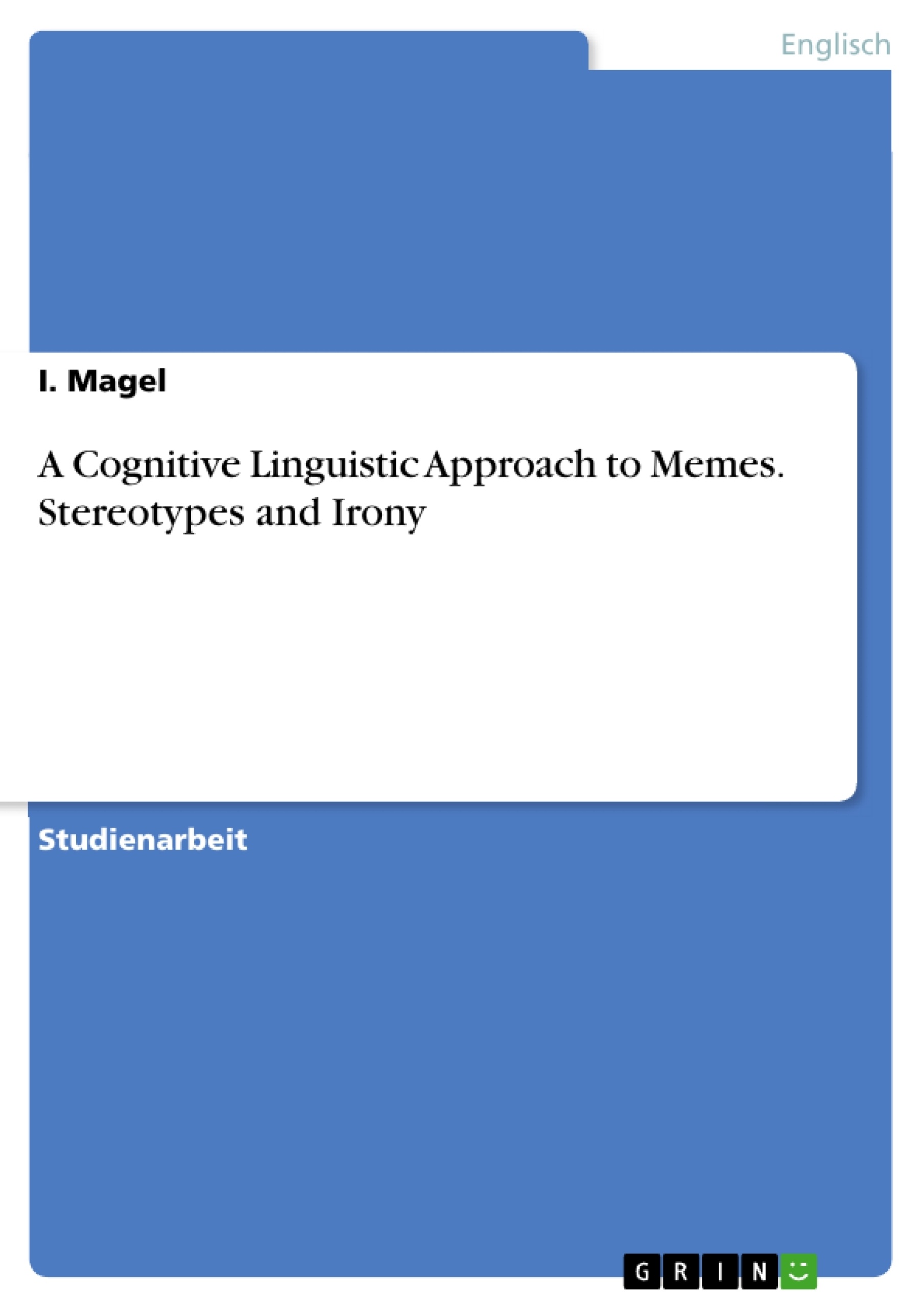In this paper I will focus on Internet memes, especially image memes, which I will analyze from a cognitive linguistics view. The first, rather theoretical section of this paper will be about the etymology of the term meme. Afterwards, I will present a few cognitive aspects of memes with particular emphasis on stereotypes and irony. These aspects will be examined by analyzing some examples.
Inhaltsverzeichnis
- 1. Einleitung
- 2. Etymologie des Begriffs Meme
- 3. Kognitiv-linguistischer Ansatz zu Memes
- 3.1 Stereotype
- 3.2 Ironie
- 3.3 Stereotype und Ironie in "Successful Black Man"
- 3.3.1 Beispiel 1
- 3.3.2 Beispiel 2
- 3.3.3 Beispiel 3
- 3.3.4 Beispiel 4
- 3.3.5 Ergebnisse
Zielsetzung und Themenschwerpunkte
Diese Arbeit untersucht Internet-Memes, insbesondere Bild-Memes, aus kognitiv-linguistischer Perspektive. Die Zielsetzung besteht darin, die Verbreitung und den kulturellen Einfluss von Memes zu analysieren und die Rolle von Stereotypen und Ironie in deren Erfolg zu beleuchten. Die Arbeit basiert auf dem Konzept der Meme von Richard Dawkins und der Erweiterung durch Susan Blackmore.
- Etymologie des Begriffs "Meme"
- Kognitiv-linguistische Analyse von Memes
- Rolle von Stereotypen in Memes
- Bedeutung von Ironie in Memes
- Analyse von Beispielen aus der "Know Your Meme"-Datenbank
Zusammenfassung der Kapitel
1. Einleitung: Die Einleitung führt in das Thema Internet-Memes ein und beschreibt deren Bedeutung als kulturelles Phänomen im digitalen Zeitalter. Sie skizziert den Fokus der Arbeit auf die kognitiv-linguistische Analyse von Bild-Memes und die Auswahl der "Know Your Meme"-Datenbank als Datenquelle. Die Einleitung legt den Grundstein für die folgenden Kapitel, indem sie den Forschungsansatz und die Methodik präzisiert.
2. Etymologie des Begriffs Meme: Dieses Kapitel beleuchtet die Herkunft des Begriffs "Meme" und dessen Bedeutung im Kontext der von Richard Dawkins entwickelten Theorie. Es wird die Ableitung vom griechischen Wort μίμῆμα (mīmēma) sowie die Verbindung zu Wörtern wie "same" und "memory" erörtert. Der Fokus liegt auf Dawkins' Definition des Memes als kultureller Replikator, analog zum biologischen Konzept des Gens, und der Bedeutung dieser Theorie für das Verständnis von kultureller Evolution. Die Weiterentwicklung der Mem-Theorie durch Susan Blackmore, inklusive der Konzepte von "Memetics", "Temes" und "Tremes", wird ebenfalls behandelt.
3. Kognitiv-linguistischer Ansatz zu Memes: Dieses Kapitel präsentiert den kognitiv-linguistischen Ansatz zur Untersuchung von Memes. Es werden die Kernprinzipien der kognitiven Linguistik erläutert und der Bezug zu Konzepten wie Prototypen und idealisierten kognitiven Modellen (ICMs) hergestellt. Die Bedeutung von Kontext und individuellen Interpretationen bei der Kategorisierung und beim Verständnis von Memes wird hervorgehoben. Der Abschnitt legt die theoretische Grundlage für die anschließende Analyse spezifischer Meme-Beispiele.
Schlüsselwörter
Internet-Meme, Kognitiv-Linguistik, Memetische Theorie, Stereotype, Ironie, Bild-Memes, Kulturelle Evolution, "Know Your Meme", Prototypen, Idealized Cognitive Models (ICMs).
Häufig gestellte Fragen (FAQ) zu: Kognitiv-linguistische Analyse von Internet-Memes
Was ist der Gegenstand dieser Arbeit?
Diese Arbeit untersucht Internet-Memes, insbesondere Bild-Memes, aus kognitiv-linguistischer Perspektive. Der Fokus liegt auf der Analyse der Verbreitung, des kulturellen Einflusses und der Rolle von Stereotypen und Ironie im Erfolg dieser Memes.
Welche Methodik wird angewendet?
Die Arbeit basiert auf dem Konzept der Meme von Richard Dawkins und Susan Blackmore und nutzt einen kognitiv-linguistischen Ansatz. Die Daten werden aus der "Know Your Meme"-Datenbank gewonnen.
Welche Themen werden behandelt?
Die Arbeit behandelt die Etymologie des Begriffs "Meme", die kognitiv-linguistische Analyse von Memes, die Rolle von Stereotypen und Ironie in Memes und die Analyse konkreter Beispiele aus der "Know Your Meme"-Datenbank. Konzepte wie Prototypen und idealisierte kognitive Modelle (ICMs) spielen eine wichtige Rolle.
Wie ist die Arbeit strukturiert?
Die Arbeit gliedert sich in eine Einleitung, ein Kapitel zur Etymologie des Begriffs "Meme", ein Kapitel zum kognitiv-linguistischen Ansatz zur Meme-Analyse und eine detaillierte Analyse von Beispielen, die Stereotype und Ironie in Memes beleuchten. Die Arbeit schließt mit einer Zusammenfassung der Kapitel und einer Liste von Schlüsselbegriffen.
Was ist die Zielsetzung der Arbeit?
Die Zielsetzung besteht darin, die Verbreitung und den kulturellen Einfluss von Internet-Memes zu analysieren und die Bedeutung von Stereotypen und Ironie für ihren Erfolg zu beleuchten.
Welche Quellen werden verwendet?
Die Arbeit stützt sich auf die Theorie der Meme von Richard Dawkins und Susan Blackmore und bezieht sich auf die "Know Your Meme"-Datenbank als primäre Datenquelle.
Welche Schlüsselwörter sind relevant?
Relevante Schlüsselwörter sind: Internet-Meme, Kognitiv-Linguistik, Memetische Theorie, Stereotype, Ironie, Bild-Memes, Kulturelle Evolution, "Know Your Meme", Prototypen, Idealized Cognitive Models (ICMs).
Welche konkreten Beispiele werden analysiert?
Die Arbeit analysiert mehrere Beispiele aus der "Know Your Meme"-Datenbank, die im Kapitel 3.3 detailliert dargestellt und unter den Aspekten Stereotyp und Ironie untersucht werden.
- Quote paper
- I. Magel (Author), 2015, A Cognitive Linguistic Approach to Memes. Stereotypes and Irony, Munich, GRIN Verlag, https://www.grin.com/document/385016



